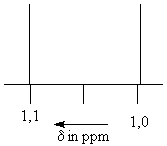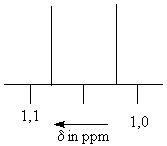87
Answers:
| Doublets
of the methyl protons in (CH3)2CHOCH(CH3)2
|
||
| bei n0 = 60 MHz (see page 81), J = 6.1 Hz (» 0.1 ppm) | bei n0 = 100 MHz, J = 6.1 Hz (= 0.061 ppm) | |
 |
 |
|
| In other words: If spectra are recorded at higher fields and - respectively - frequencies while using the d scale, then the spacing of the multiplet lines becomes tighter, while the spacing of the signals remains constant. |
This effect is one of the reasons why spectra are recorded at increasingly higher frequencies (Currently up to 900 MHz) - if there is a high degree of coupling, multiplets may start to overlap if the spectra are recorded at low fields (= frequencies). At higher fields the difference between chemical shift and spin-spin coupling effects increases, and the resolution of the spectra improves.
Now continue to page 85!